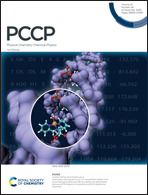Theoretical insights on acceptor–donor dyads for organic photovoltaics†
Abstract
The field of organic photovoltaics has witnessed a steady growth in the last few decades and a recent renewal with the blossoming of single-material organic solar cells (SMOSCs). However, due to the intrinsic complexity of these devices (both in terms of their size and of the condensed phases involved), computational approaches to accurately predict their geometrical and electronic structure and to link their microscopic properties to the observed macroscopic behaviour are still lacking. In this work, we have focused on the rationalization of transport dynamics and we have set up a computational approach that makes a combined use of classical simulations and Density Functional Theory with the aim of disclosing the most relevant electronic and structural features of dyads used for SMOSC applications. As a prototype dyad, we have considered a molecule that consists in a dithiafulvalene-functionalized diketopyrrolopyrrole (DPP), acting as an electron donor, covalently linked to a fulleropyrrolidine (Ful), the electron acceptor. Our results, beside a quantitative agreement with experiments, show that the overall observed mobilities result from the competing packing mechanisms of the constituting units within the dyad both in the case of crystalline and amorphous phases. As a consequence, not all stable polymorphs have the same efficiency in transporting holes or electrons which often results in a highly directional carrier transport that is not, in general, a desirable feature for polycrystalline thin-films. The present work, linking microscopic packing to observed transport, thus opens the route for the in silico design of new dyads with enhanced and controlled structural and electronic features.



 Please wait while we load your content...
Please wait while we load your content...